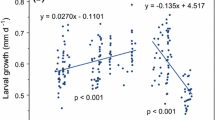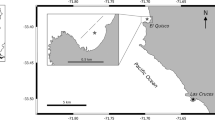Abstract
Understanding the factors leading to inter-annual variation in recruitment of animals with complex life cycles is a key goal for ecology and the sustainable management of animal resources, such as fisheries. We used otolith microstructure to determine larval growth rates of post-larval King George whiting, Sillaginodes punctata, in seagrass beds of Port Phillip Bay, Australia. Inter-annual variation in growth determined early in the pelagic, offshore larval-stage was highly correlated with post-larval abundance (a predictor of fishery recruitment). Sea surface temperature measured near the presumed spawning area off Western Victoria was significantly correlated with larval growth, and was also significantly correlated with post-larval abundance in Port Phillip Bay. Increased water temperature would have had the direct effect of increasing larval growth and therefore contributing to larval survival, but may also have been indicative of enhanced physical transport and/or plankton productivity. Overall, larval growth rate of King George whiting is a very strong predictor of post-larval abundance, which in turn will influence fishery recruitment in 3–5 years' time.




Similar content being viewed by others
References
Anderson JT (1988) A review of size-dependent survival during pre-recruit stages of fishes in relation to recruitment. J Northwest Atl Fish Sci 8:55–66
Bailey MC, Heath MR (2001) Spatial variability in the growth rate of blue whiting (Micromesistius poutassou) larvae at the shelf edge west of the UK. Fish Res 50:73–87
Barber MC, Jenkins GP (2001) Differential effects of food and temperature lead to decoupling of short-term otolith and somatic growth rates in juvenile King George whiting. J Fish Biol 58:1320–1330
Bergenius MAJ, Meekan MG, Robertson DR, McCormick MI (2002) Larval growth predicts the recruitment success of a coral reef fish. Oecologia 131:521–525
Bervan KA (1990) Factors affecting population fluctuations in larval and adult stages of the wood frog (Rana sylvatica). Ecology 71:1599–1608
Black KP, Hatton D, Rosenberg M (1993) Locally and externally driven dynamics of a large semi-enclosed bay in southern Australia. J Coast Res 9:509–538
Broitman BR, Blanchette CA, Gaines SD (2005) Recruitment of intertidal invertebrates and oceanographic variability at Santa Cruz Island, California. Limnol Oceanogr 50:1473–1479
Bruce BD (1995) Larval development of King George whiting, Sillaginodes punctata, school whiting, Sillago bassensis, and yellow fin whiting, Sillago schomburgkii (Percoidei: Sillaginidae), from South Australian waters. Fish Bull 93:27–43
Bulthuis DA (1981) Distribution of seagrasses in Port Phillip Bay. Report for task R105. Marine Science Laboratories, Ministry for Conservation, Victoria
Bulthuis DA, Axelrad DM, Mickelson MJ (1992) Growth of the seagrass Heterozostera tasmanica limited by nitrogen in Port Phillip Bay, Australia. Mar Ecol Prog Ser 89:269–277
Campana SE (1996) Year-class strength and growth rate in young Atlantic cod Gadus morhua. Mar Ecol Prog Ser 135:21–26
Campana SE, Jones CM (1992) Analysis of otolith microstructure data. In: Stevenson DK, Campana SE (eds) Otolith microstructure examination and analysis. Canada Communication Group, Ottawa, pp 73–100
Caley MJ, Carr MH, Hixon MA, Hughes TP, Jones GP, Menge BA (1996) Recruitment and the local dynamics of open marine populations. Annu Rev Ecol Syst 27:477–500
Chambers RC, Leggett WC (1987) Size and age at metamorphosis in marine fishes: an analysis of laboratory-reared winter flounder (Pseudopleuronectes americanus) with a review of variation in other species. Can J Fish Aquat Sci 44:1936–1947
Cirano M, Middleton JF (2004) Aspects of the mean wintertime circulation along Australia’s southern shelves. J Phys Oceanogr 34:668–684
Cowen RK (1991) Variation in the planktonic larval duration of the temperate wrasse Semicossyphus pulcher. Mar Ecol Prog Ser 69:9–15
Fowler AJ, McLeay L, Short DA (2000) Spatial variation in size and age structures and reproductive characteristics of the King George whiting (Percoidei: Sillaginidae) in South Australian waters. Mar Freshwater Res 51:11–22
Fowler AJ, Short DA (1996) Temporal variation in the early life-history characteristics of the King George whiting (Sillaginodes punctata) from analysis of otolith microstructure. Mar Freshwater Res 47:809–818
Hare JA, Cowen RK (1997) Size, growth, development, and survival of the planktonic larvae of Pomatomus saltatrix (Pisces: Pomatomidae). Ecology 78:2415–2431
Harris GP, Davies P, Nunez M, Meyers G (1988) Inter-annual variability in climate and fisheries in Tasmania. Nature 333:754–757
Houde ED (1987) Fish early life dynamics and recruitment variability. Am Fish Soc Symp 2:17–29
Jenkins GP (2005) The influence of climate on the fishery recruitment of a temperate, seagrass associated fish, the King George whiting, Sillaginodes punctata. Mar Ecol Prog Ser 288:263–271
Jenkins GP, Black KP (1994) Temporal variability in settlement of a coastal fish, the King George whiting, Sillaginodes punctata, is determined by low-frequency hydrodynamics. Limnol Oceanogr 39:1744–1754
Jenkins GP, Black KP, Hamer PA (2000) Determination of spawning areas and larval advection pathways for King George whiting in south eastern Australia using otolith microstructure and hydrodynamic modelling. I. Victoria. Mar Ecol Prog Ser 199:231–242
Jenkins GP, Black KP, Keough MJ (1999) The role of passive transport and the influence of vertical migration on the pre-settlement distribution of a temperate, demersal fish: numerical model predictions compared with field sampling. Mar Ecol Prog Ser 184:259–271
Jenkins GP, Black KP, Wheatley MJ, Hatton DN (1997) Temporal and spatial variability in recruitment of a temperate, seagrass-associated fish is largely determined by physical processes in the pre- and post-settlement phases. Mar Ecol Prog Ser 148:23–35
Jenkins GP, Keough MJ, Hamer PA (1998) The contributions of habitat structure and larval supply to broad-scale recruitment variability in a temperate zone, seagrass-associated fish. J Exp Mar Biol Ecol 226:259–278
Jenkins GP, May HMA (1994) Variation in settlement and larval duration of King George whiting, Sillaginodes punctata (Sillaginidae), in Swan Bay, Victoria, Australia. Bull Mar Sci 54:281–296
Jenkins GP, Wheatley MJ (1998) The influence of habitat structure on nearshore fish assemblages in a southern Australian embayment: comparison of shallow seagrass, reef algal, and unvegetated habitats, with emphasis on their importance to recruitment. J Exp Mar Biol Ecol 221:147–172
Kailola PJ, Williams MJ, Stewart PC, Reichelt RE, McNee A, Grieve C (1993) Australian fisheries resources. Bureau of Resources Sciences and Fisheries Research and Development Corporation, Canberra
Leggett WC, DeBlois E (1994) Recruitment in marine fishes: Is it regulated by starvation and predation in the egg and larval stages? Neth J Sea Res 32:119–134
Longmore AR, Cowdell RA, Gibbs CF (1990) Monitoring Port Phillip Bay water quality 1985–1986. Environmental Protection Authority scientific report series 89/003. Environmental Protection Authority
Marshall DJ, Bolton TF, Keough MJ (2003) Offspring size affects the post-metamorphic performance of a colonial marine invertebrate. Ecology 84:3131–3137
McCormick MI (2003) Consumption of coral propagules after mass spawning enhances larval quality of damselfish through maternal effects. Oecologia 136:37–45
Meekan MG, Carleton JH, McKinnon AD, Flynn K, Furnas M (2003) What determines the growth of tropical reef fish larvae in the plankton: food or temperature? Mar Ecol Prog Ser 256:193–204
Meekan MG, Fortier L (1996) Selection for fast growth during the larval life of Atlantic cod Gadus morhua on the Scotian Shelf. Mar Ecol Prog Ser 137:25–37
Miller TJ, Crowder LB, Rice JA, Marschall EA (1988) Larval size and recruitment mechanisms in fishes: toward a conceptual framework. Can J Fish Aquat Sci 45:1657–1670
Norcross BL, Shaw RF (1984) Oceanic and estuarine transport of fish eggs and larvae: a review. Trans Am Fish Soc 113:153–165
Phillips NE (2002) Effects of nutrition mediated larval condition on juvenile performance in a marine mussel. Ecology 83:2562–2574
Polacheck T, Mountain D, McMillan D, Smith W, Berrien P (1992) Recruitment of the 1987 year class of Georges Bank haddock (Melanogrammus aeglefinus): the influence of unusual larval transport. Can J Fish Aquat Sci 49:484–496
Pyper BJ, Peterman RM (1997) Comparison of methods to account for autocorrelation in correlation analyses of fish data. Can J Fish Aquat Sci 55:2127–2140
Raventos N, Macpherson E (2001) Planktonic larval duration and settlement marks on the otoliths of Mediterranean littoral fishes. Mar Biol 138:1115–1120
Roughgarden J, Gaines S, Possingham H (1988) Recruitment dynamics in complex life cycles. Science 241:1460–1466
Searcy SP, Sponaugle S (2001) Selective mortality during the larval–juvenile transition in two coral reef fishes. Ecology 82:2452–2470
Shima JS, Findlay AM (2002) Pelagic larval growth rate impacts benthic settlement and survival of a temperate reef fish. Mar Ecol Prog Ser 235:303–309
Sirois P, Dodson JJ (2000) Critical periods and growth-dependent survival of larvae of an estuarine fish, the rainbow smelt Osmerus mordax. Mar Ecol Prog Ser 203:233–245
Takahashi M, Watanabe Y (2004) Growth rate-dependent recruitment of Japanese anchovy Engraulis japonicus in the Kuroshio-Oyashio transitional waters. Mar Ecol Prog Ser 266:227–238
Takasuka A, Aoki I, Mitani I (2003) Evidence of growth-selective predation on larval Japanese anchovy Engraulis japonicus in Sagami Bay. Mar Ecol Prog Ser 252:223–238
Taylor BW, Anderson CR, Peckarsky BL (1998) Effects of size at metamorphosis on stonefly fecundity, longevity and reproductive success. Oecologia 114:494–502
Vigliola L, Meekan MG (2002) Size at hatching and planktonic growth determine post-settlement survivorship of a coral reef fish. Oecologia 131:89–93
Werner FE, Quinlan JA, Blanton BO, Luettich RA Jr (1997) The role of hydrodynamics in explaining variability in fish populations. J Sea Res 37:195–212
Wilbur HM (1980) Complex life cycles. Annu Rev Ecol Syst 11:67–93
Wilson DT, Meekan MG (2002) Growth-related advantages for survival to the point of replenishment in the coral reef fish Stegastes partitus (Pomacentridae). Mar Ecol Prog Ser 231:247–260
Acknowledgements
We wish to thank David Hatton and a number of other helpers and volunteers for assistance with the collection of post-larval whiting. The SST data were obtained from the CSIRO Marine Laboratories with the assistance of Glenelg Smith. Thanks to Steve Swearer for giving us access to his microscope/video-digitising equipment. Finally, thanks to Paul Hamer and Jeremy Hindell for their helpful comments on the manuscript.
Author information
Authors and Affiliations
Corresponding author
Additional information
Communicated by Roland Brandl
Rights and permissions
About this article
Cite this article
Jenkins, G.P., King, D. Variation in larval growth can predict the recruitment of a temperate, seagrass-associated fish. Oecologia 147, 641–649 (2006). https://doi.org/10.1007/s00442-005-0336-5
Received:
Accepted:
Published:
Issue Date:
DOI: https://doi.org/10.1007/s00442-005-0336-5




